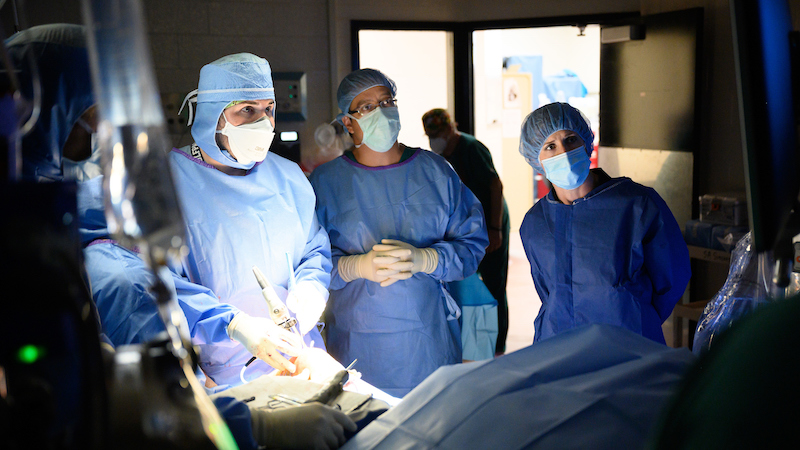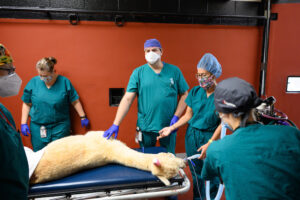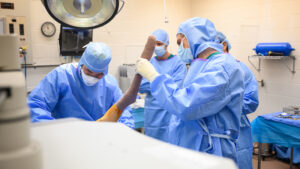Innovative Knee Surgery Puts Alpaca Back on His Feet

Hou Rah is an award-winning white Huacaya alpaca living on a farm in Pittsboro. His primary assignment: mating to produce show-worthy offspring.
Like any job, it has its occupational hazards.
Sometimes Hou Rah takes a little too long in the course of his work. This can make his female partners impatient. Not long ago, one of them expressed her frustration by delivering a sharp, traumatic blow to his leg, resulting in torn ligaments in his left rear knee, leaving him lame, in extreme pain and unable to perform his regular duties.
This led to a trip to the NC State Veterinary Hospital. There, Hou Rah was introduced to Daniel Duffy, assistant professor of orthopedic surgery. After thoroughly evaluating the alpaca’s condition, Duffy performed an innovative surgery rarely done on alpacas that put the animal back on his feet and eventually back on the job.
Duffy says that given the debilitating nature of the injury, it is common to euthanize alpacas with similar trauma. Hou Rah had suffered both an anterior cruciate ligament rupture and a complex meniscus tear. “In a large animal patient, it’s very important to remove the source of pain and stabilize the knee joint to counteract the large forces encountered during normal activity,” Duffy says.

The specific surgery Duffy performed was an arthroscopic meniscectomy, a procedure to remove parts of the torn painful meniscus from the knee using arthroscopic equipment followed by a tibial plateau leveling osteotomy — TPLO surgery.
It is a surgery that Duffy has often performed on dogs, and he was confident that the technique could be adapted to an alpaca using specialized locking equipment that was ordered specifically for Hou Rah’s surgery. The locking plate secures the modified parts of the patient’s tibia together to assure healing in the proper position, and a special larger plate had to be used for a larger animal like an alpaca.
During a TPLO surgery, a curved cut is made in the tibia from the front to the back, much like half a smiley face. The top section of the tibia is then rotated backward until the angle of the weight bearing surface of the tibia is at an appropriate level. A metal locking bone plate and screws is then used to affix the two sections of tibia in the desired positions, allowing the tibia to heal in its new configuration.
Duffy specializes in minimally invasive surgical techniques, allowing for precise treatment to be given to the meniscus and remove the torn portion of the anterior cruciate ligament while reducing the risk of infection and post-operative pain. That was literally just what the doctor ordered for Hou Rah.
At a follow-up visit for an examination and radiographs 12 weeks after surgery, Hou Rah was well on the way to full recovery.
“He had a full and expected range of motion in the knee” Duffy says, “he had no residual instability or pain that was present pre surgery.”
After reviewing the medical literature, Duffy says he found only one other instance when a TPLO surgery had been performed in an alpaca.

“Arthroscopic examination and targeted meniscal treatment really make this case different from other alpacas treated in the current literature” Duffy says.
Performing innovative surgeries on a variety of species is not new to Duffy, an orthopedic surgeon who is a diplomate of the American and European colleges of veterinary surgeons. He grew up on a working sheep farm on the east coast of Yorkshire in rural northeast England. He graduated from the University of Edinburgh and worked with his parents at their small animal mixed practice in his free time before coming to the United States.
“I’ve worked on a variety of exotic animals, including chinchillas, ferrets, raptors, hedgehogs and turtles,” Duffy says. In those animals that are not domesticated, the goal is to successfully return them to the wild. “We’ve also operated on owls, eagles, hawks and kestrels,” he adds.
Now Duffy can include a hard-working alpaca on his list of successfully treated exotic patients.
~Steve Volstad/NC State Veterinary Medicine


